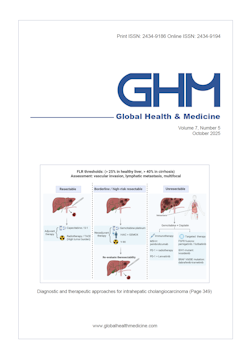Global Health & Medicine 2024;6(4):244-250.
Evaluation of X-ray protective goggles in mitigating eye lens radiation exposure during radiopharmaceutical handling and patient care in nuclear medicine
Oikawa T, Saito K, Kurihara K, Horikawa D, Uruno K, Kajiwara H, Ohashi S, Hotta M, Yagi N, Kitamura H, Hasegawa S, Minamimoto R
The aim of this study is to estimate eye lens exposure dose when handling radiopharmaceuticals and interacting with patients receiving radiopharmaceuticals, and to verify the usefulness of X-ray protective goggles in mitigating such radiation exposure using phantoms. To evaluate radiation exposure during the handling of radiopharmaceuticals, we employed a fluorescent glass dosimeter to measure the radiation doses associated with 99mTc, 123I, 131I, 111In, and 18F at distances of 30 cm and 60 cm, followed by calculation of the 3 mm dose equivalent rate (3DER). We then estimated the dose reduction rates for various scenarios, including the use of syringe shields and X-ray protective goggles with lead equivalences of 0.07, 0.15, 0.75, and 0.88 mmPb, as well as their combined application. X-ray protective goggles with lead equivalence of 0.75 mmPb outperformed those with 0.07 mmPb and 0.15 mmPb, for all radionuclides and at both source distances. X-ray protective goggles with 0.88 mmPb outperformed those with 0.75 mmPb during handling of 131I and 111In at a distance of 30 cm. In the remaining scenarios, X-ray protective goggles with 0.88 mmPb resulted in marginal reductions or no discernible additional effects. The overall shielding effect of X-ray protective goggles was less pronounced for 131I and 18F, but the combined use of a syringe shield with X-ray protective goggles with 0.75 or 0.88 mmPb improved the dose reduction rate for all scenarios. In simulating patient care, X-ray protective goggles with 0.88 mmPb demonstrated a dose reduction effect of approximately 50% or more. X-ray protective goggles could reduce the 3DER for the eye lens, and were more effective when combined with a syringe shield. It is valid to use a lead equivalence of 0.88 mmPb to fully harness the protective capabilities of X-ray shielding goggles when dealing with all five types of nuclides in clinical settings.
DOI: 10.35772/ghm.2024.01023







